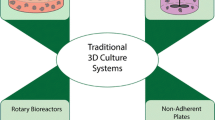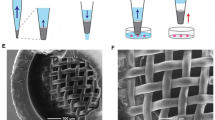Abstract
Purpose
Cell migration/invasion assays are widely used in commercial drug discovery screening. 3D printing enables the creation of diverse geometric restrictive barrier designs for use in cell motility studies, permitting on-demand assays. Here, the utility of 3D printed cell exclusion spacers (CES) was validated as a cell motility assay.
Methods
A novel CES fit was fabricated using 3D printing and customized to the size and contour of 12 cell culture plates including 6 well plates of basal human brain vascular endothelial (D3) cell migration cells compared with 6 well plates with D3 cells challenged with 1uM cytochalasin D (Cyto-D), an F-actin anti-motility drug. Control and Cyto-D treated cells were monitored over 3 days under optical microscopy.
Results
Day 3 cell migration distance for untreated D3 cells was 1515.943μm ± 10.346μm compared to 356.909μm ± 38.562μm for the Cyt-D treated D3 cells (p < 0.0001). By day 3, untreated D3 cells reached confluency and completely filled the original voided spacer regions, while the Cyt-D treated D3 cells remained significantly less motile.
Conclusions
Cell migration distances were significantly reduced by Cyto-D, supporting the use of 3D printing for cell exclusion assays. 3D printed CES have great potential for studying cell motility, migration/invasion, and complex multi-cell interactions.







Similar content being viewed by others
Abbreviations
- CES:
-
Cell exclusion spacers
- Cyto-D:
-
Cytochalasin D
- D3 cells:
-
Human brain vascular endothelial cells
- FDA:
-
Food and drug administration
- Migration/invasion:
-
Migration and invasion
- PBS-EDTA:
-
Phosphate-buffered saline/ethylenediaminetetraacetic acid
References
Justus CR, Leffler N, Ruiz-Echevarria M, Yang LV. In vitro cell migration and invasion assays. J Vis Exp. 2014;(88) http://www.jove.com/video/51046/in-vitro-cell-migration-and-invasion-assays. Accessed March 22, 2018.
Kramer N, Walzl A, Unger C, Rosner M, Krupitza G, Hengstschläger M, et al. In vitro cell migration and invasion assays. Mutat Res Rev Mutat Res. 2013;752(1):10–24.
Javaherian S, O’Donnell KA, McGuigan AP. A Fast and accessible methodology for micro-patterning cells on standard culture substrates using Parafilm™ inserts. Neves NM, editor. PLoS One. 2011;6(6):e20909.
Weisman JA, Nicholson JC, Tappa K, Jammalamadaka U, Wilson CG, Mills DK. Antibiotic and chemotherapeutic enhanced three-dimensional printer filaments and constructs for biomedical applications. Int J Nanomedicine. 2015;10:357–70.
Ballard DH, Weisman JA, Jammalamadaka U, Tappa K, Alexander JS, Griffen FD. Three-dimensional printing of bioactive hernia meshes: in vitro proof of principle. Surgery. 2017;161(6):1479–81.
Weisman JA, Ballard DH, Jammalamadaka U, et al. 3D printed antibiotic and chemotherapeutic eluting catheters for potential use in interventional radiology: in vitro proof of concept study. Acad Radiol. 2018; [Ahead of print]; https://doi.org/10.1016/j.acra.2018.03.022.
Ballard DH, Trace AP, Ali S, Hodgdon T, Zygmont ME, DeBenedectis CM, et al. Clinical applications of 3D printing: primer for radiologists. Acad Radiol. 2018;25(1):52–65.
Hodgdon T, Danrad R, Patel MJ, Smith SE, Richardson ML, Ballard DH, et al. Logistics of three-dimensional printing: primer for radiologists. Acad Radiol. 2018;25(1):40–51.
Boyer CJ, Ballard DH, Weisman JA, Hurst S, McGee DJ, Mills DK, et al. Three-dimensional printing antimicrobial and radiopaque constructs. 3D Print Addit Manuf. 2018;5(1):29–35.
Tappa K, Jammalamadaka U, Ballard DH, Bruno T, Israel MR, Vemula H, et al. Medication eluting devices for the field of OBGYN (MEDOBGYN): 3D printed biodegradable hormone eluting constructs, a proof of concept study. PLoS One. 2017;12(8):e0182929.
Kang H-W, Lee SJ, Ko IK, Kengla C, Yoo JJ, Atala A. A 3D bioprinting system to produce human-scale tissue constructs with structural integrity. Nat Biotechnol. 2016;34(3):312–9.
Laronda MM, Rutz AL, Xiao S, Whelan KA, Duncan FE, Roth EW, et al. A bioprosthetic ovary created using 3D printed microporous scaffolds restores ovarian function in sterilized mice. Nat Commun. 2017;8:15261.
Casella JF, Flanagan MD, Lin S. Cytochalasin D inhibits actin polymerization and induces depolymerization of actin filaments formed during platelet shape change. Nature. 1981;293(5830):302–5.
Di Prima M, Coburn J, Hwang D, et al. Additively manufactured medical products–the FDA perspective. 3D Print Med. 2016;2:1.
Christensen A, Rybicki FJ. Maintaining safety and efficacy for 3D printing in medicine. 3D Printing in Medicine. 2017;3 https://doi.org/10.1186/s41205-016-0009-5.
Leng S, McGee K, Morris J, Alexander A, Kuhlmann J, Vrieze T, et al. Anatomic modeling using 3D printing: quality assurance and optimization. 3D Printing in Medicine. 2017;3 https://doi.org/10.1186/s41205-017-0014-3.
Morrison RJ, Kashlan KN, Flanangan CL, Wright JK, Green GE, Hollister SJ, et al. Regulatory considerations in the design and manufacturing of implantable 3d-printed medical devices. Clin Transl Sci. 2015;8(5):594–600.
Acknowledgments and Disclosures
The authors would like to thank Louisiana State University Health Sciences Center Shreveport for supporting this research. The authors have no conflicts of interest to disclose.
Author information
Authors and Affiliations
Corresponding author
Additional information
Guest Editors: Tony Zhou and Tonglei Li
Rights and permissions
About this article
Cite this article
Boyer, C.J., Ballard, D.H., Yun, J.W. et al. Three-Dimensional Printing of Cell Exclusion Spacers (CES) for Use in Motility Assays. Pharm Res 35, 155 (2018). https://doi.org/10.1007/s11095-018-2431-4
Received:
Accepted:
Published:
DOI: https://doi.org/10.1007/s11095-018-2431-4




